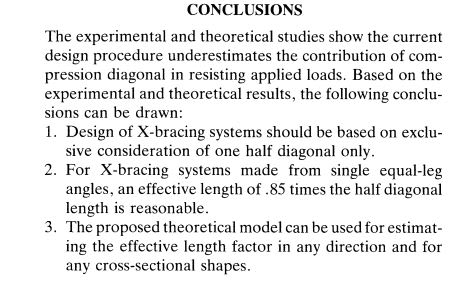Everynameistaken
Structural
Hi All,
I see there have been several threads on this already but do not seem to answer our specific question.
We have a low rise building < 15m using a system that has low ductility. As such we are permitted to use tension only bracing and no strict capacity design (CSA S16 conventional construction)
The most efficient is to use cross braces angle, we use two bolts at each end and connect in the middle with a single bolt.
I have usually considered the central connection point as the length when checking the KL/r limit for the tension brace.
Ie. 10m node to node, with a cross so the length is now halved so my kL = 1.0 x (0.5 x 10m). I know there is quite a bit of conflicting literature on this point, but since we are not relying on this brace point for a compression member I am on with this.
My question is more about which r should be used when checking the kl/r limit. For a system with very low ductility (R < 2.0) the limit for kL/r < 300.
Since the angles are held square at each and by the gusset and at the centre we have typically used the r about the geometric axis. These are the higher r values from the code. The principal axes has a very low r in one direction and could impact the angle size due only to the slenderness limit.
My understanding , for tension only systems with low ductility, this kl/r < 300 limit is more about sag and if the sections are held in place and connected together, the geometric axes seem to make sense.
Let me know your thoughts
I see there have been several threads on this already but do not seem to answer our specific question.
We have a low rise building < 15m using a system that has low ductility. As such we are permitted to use tension only bracing and no strict capacity design (CSA S16 conventional construction)
The most efficient is to use cross braces angle, we use two bolts at each end and connect in the middle with a single bolt.
I have usually considered the central connection point as the length when checking the KL/r limit for the tension brace.
Ie. 10m node to node, with a cross so the length is now halved so my kL = 1.0 x (0.5 x 10m). I know there is quite a bit of conflicting literature on this point, but since we are not relying on this brace point for a compression member I am on with this.
My question is more about which r should be used when checking the kl/r limit. For a system with very low ductility (R < 2.0) the limit for kL/r < 300.
Since the angles are held square at each and by the gusset and at the centre we have typically used the r about the geometric axis. These are the higher r values from the code. The principal axes has a very low r in one direction and could impact the angle size due only to the slenderness limit.
My understanding , for tension only systems with low ductility, this kl/r < 300 limit is more about sag and if the sections are held in place and connected together, the geometric axes seem to make sense.
Let me know your thoughts

